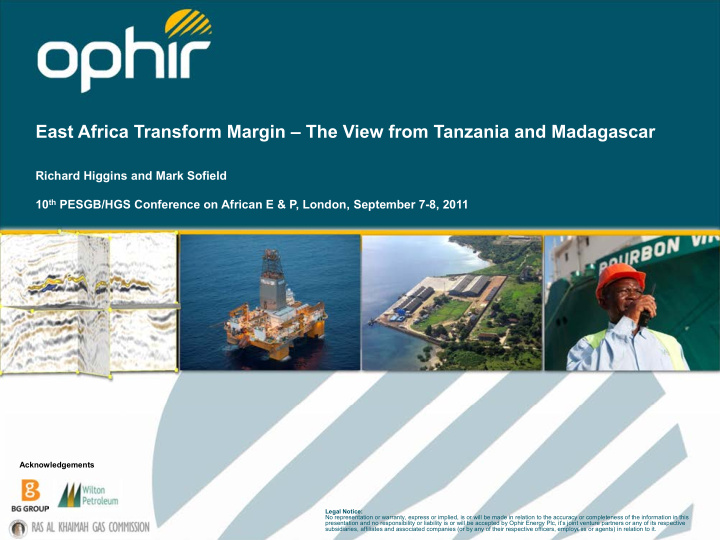



East Africa Transform Margin – The View from Tanzania and Madagascar Richard Higgins and Mark Sofield 10 th PESGB/HGS Conference on African E & P, London, September 7-8, 2011 Acknowledgements Legal Notice: No representation or warranty, express or implied, is or will be made in relation to the accuracy or completeness of the information in this presentation and no responsibility or liability is or will be accepted by Ophir Energy Plc, it’s joint venture partners or any of its respective subsidiaries, affiliates and associated companies (or by any of their respective officers, employees or agents) in relation to it. 1
Agenda • Location & Recent Activity • Regional Tectonic Elements • Influence on Petroleum System Elements • Summary MOZAMBIQUE TANZANIA 2
Recent Activity – East Africa • Multiple 2D and 3D Seismic surveys acquired since 2005 • Drilling campaigns conducted in Tanzania (Ophir/BG) and Mozambique (Anadarko et al.) in 2010/2011 • Seven gas discoveries Pweza Gas Discovery Chewa Gas Discovery • Various farmin/farm outs in Chaza Gas Discovery Tanzania and Kenya Windjammer Gas Discovery Barquentine Gas Discovery Lagosta Gas Discovery • Licence signatures in Kenya Tubarão Gas Discovery Ironclad Oil Shows 3
Recent Discoveries – Tanzania • Strong relationship between seismic amplitude anomalies and gas-bearing reservoirs. • Nearby targets with similar seismic characteristics now substantially de-risked. • Further 3D seismic surveys have been acquired and are currently being processed. 4
Regional Tectonics • Karroo continental rifting • Development of “passive margin” successor basins • Late Carboniferous to Early Jurassic • East African Tertiary Doming • Gondwanaland break-up • Initial opening ~180Ma (NW-SE) • N-S opening from 160Ma to 120 Ma 5
Tanzania - Gravity • Significant change in gravity signature across the Davie Fracture Zone (DFZ), B4 separating continental and oceanic crust. Seagap Fault Zone • Continental crust dominated by N-S B3 trending anomalies that appear to step across NE-SW trending lineaments. Davie Fracture Zone EP B1 MASAI • NE-SW lineaments interpreted to BASEMENT SPUR represent Early Jurassic rift faults • N-S anomalies possibly represent Cretaceous structures generated during Jurassic to Aptian, coincident with movement along the DFZ. • N-S structures reactivated during Oligocene to Recent. 6
Seagap Fault Zone • Triassic/Jurassic Rift Faulting • Generation of N-S Seagap Fault Zone during Jurassic to Aptian? Reactivation of rift faults? • Oligocene onset of reactivation (transtensional in above example) • Pliocene reactivation (generates transpressional anticline in above example) 7
Seagap Fault Zone Transtension Transpression 8
Seagap Fault Zone A SEMBLANCE Riedel? A B Restraining B Bend C C D Releasing Bend D Modified from Mikenorton, Wikipedia, 2009 9
Tanzania - Onshore From Nicholas et al. , (2007) From Nicholas et al. , (2007) 10
Structural Control on Reservoir Input S N East Pande 11
Reservoir Quaternary Holocene Pleistocene Quaternary and Tertiary Tertiary Mesozoic Tertiary and Cretaceous Cretaceous Lower Cretaceous Cretaceous and Jurassic Jurassic Lower Jurassic Jurassic and Triassic Triassic Lower Triassic • Fault-controlled Mesozoic and Paleozoic Cretaceous through Carboniferous sediment input Jurassic through Carboniferous Paleozoic Permian Triassic and Permian • Long-lived sediment Permian-Carboniferous Carboniferous input from quartz-rich Carboniferous and Devonian Devonian provenance Upper and Middle Devonian Devonian and Silurian Silurian Silurian-Ordivician Ordivician Ordivician-Cambrian Cambrian Precambrian Paleozoic-Precambrian Proterozoic Quaternary extrusive and intrusive Tertiary extrusive and intrusivei Mesozoic extrusive and intrusive Mesozoic-Paleozoic extrusive and intrusive Paleozoic extrusive and intrusive Kimberlite Subsurface salt dome Open Water Bathymetry 0 to 200 200 to 1000 1000 to 2000 2000 to 3000 > 3000 12
Madagascar - Gravity • NE-SW rift faults • NW-SE transfer zones • Deep structural control on sediment input and fault linkage 13
An East African Deepwater Cretaceous Source Rock? Duvalia Formation (Berriasian to Aptian shallow to deep marine 249 facies) in Southern MB Thin Aptian Shales Morandava Basin – TOCs up to 9% potential for an Excellent quality Lower Cret. AFRICA source rock – TOCs average 3.74%, max 26.3%, HI Ave 167, Max Early Aptian source rocks 403. in Outenqua Basin Africa NV Alb-Cen-Tur in Northern Morandava Basin – Greater potential for oil and gas India source rock. TOC 0.8 to ANTARCTICA 3.4%, HI max 240. Serinam-1 North Morondava Basin– 692 Light oil/wet gas source Valanginian organic rich sediments India rock pot. in 15m Lwr Cret 45m thick. TOCs up to 18% (Haut-Barrem). TOC 1.7 to 330+511 Barremian-Aptian organic rich 693 9.3%, HI max 248. shales up to 35m thick Aptian organic rich sediments 68m TOCs 3 to 16% thick. TOCs up to 4% Antarctica APTIAN RECONSTRUCTION APTIAN RECONSTRUCTION • DSDP 330+511 – Barremian-Aptian organic rich shales up to 35m thick – TOCs 3 to 16% • Aptian source rocks in Outeniqua Basin, South Africa. • DSDP 249 – Thin Aptian shales with TOCs up to 9% • DSDP 693 – Aptian organic rich sediments 68m thick – TOCs up to 4% 14
An East African Deepwater Cretaceous Source Rock? Songo Songo Lower Cretaceous (contamination?) Winganyongo & SS 5 – TOCs up to 11% Ruaruke SS7 – TOC up to 5% Lower Cretaceous SS8 – TOC up to 1.57% Samples measured TOCs of 18% Semi-restricted circulation? Mid-Ocean TANZANIA RTI Ridge Mocimboa-1 Apt-Alb Slope fan deposition “increasing TOC (>1%) with depth, with organic (type III) properties in Albian shales at the base of the well” Open Circulation Marginal ridges along the continental side of the (shear) margin perhaps provides local restricted circulation & Lower Cretaceous is considered to have gas-prone anoxic conditions potential near-shore, but could the deepwater be oil-prone? 15
Summary Recent discoveries to the west of the DFZ herald the start of an exciting period of hydrocarbon exploration offshore East Africa. Tanzanian acreage appears have been significantly influenced by strike slip tectonics associated with the DFZ and Tertiary reactivation. Deepwater Cretaceous source rock in East Africa? 2 nd phase of 3D seismic acquired offshore Tanzania (Blocks 1, 3 and 4) in Q1 2011, with a further 3D survey planned for East Pande in Q4 2011. Drilling planned to recommence offshore Tanzania during late 2011 / early 2012.
Recommend
More recommend